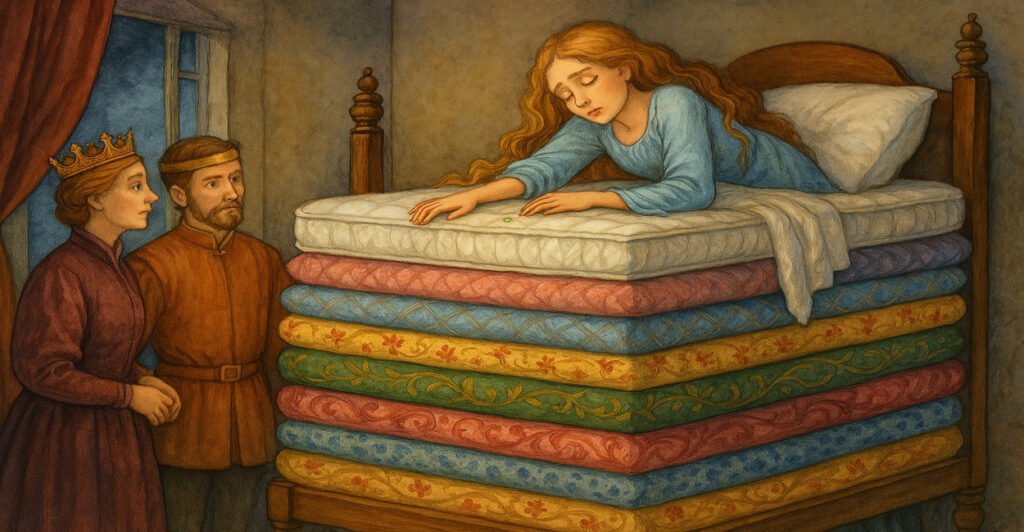Want to Read Stories?
Want to Read Stories?

Imagine a single pea tucked beneath twenty mattresses causing sleepless nights for a royal guest. Strange? Perhaps. But The Princess and the Pea is far more than just a whimsical fairy tale. This timeless story holds deeper meanings and unexpected moral lessons that still resonate today.
At Storyious, where storytelling fuels imagination and character growth, we believe classic fairy tales deserve a closer look, especially when they hold wisdom for modern life. In this blog, we’ll explore the origins, symbolism, and powerful moral teachings hidden within The Princess and the Pea, all crafted for our readers who love moral stories with lasting value.
The Princess and the Pea was written by Hans Christian Andersen and first published in 1835. Though short and simple, this story has endured for centuries, often appearing in children’s books, movies, and plays.
So, what makes the tale of a young woman tested by a pea so fascinating?
For readers in the United States and beyond, this story remains one of the most intriguing princess bedtime stories passed down through generations.
Before we unpack its deeper layers, let’s revisit the story.
A prince is in search of a true princess to marry. Despite meeting many candidates, none of them seems quite right. One stormy night, a young woman claiming to be a princess arrives at the castle, drenched and tired.
To verify her identity, the queen places a small pea beneath twenty mattresses and twenty featherbeds. The next morning, the girl complains that she couldn’t sleep due to something hard in the bed. Her sensitivity proves she must be a real princess—only someone truly noble could feel a single pea through all those layers.
The prince and the girl marry, and the pea is placed in a museum, symbolizing a test of authenticity and royal merit. Their union is seen as a celebration of truth and sincerity triumphing over pretense and appearances.
Beneath the fairy-tale simplicity lies a symbolic story about authenticity, sensitivity, and self-worth.
In moral storytelling, small things often symbolize larger truths. The pea, small yet disruptive, serves as a test of real character. It challenges our assumptions: Could something so tiny determine something so important?
The pea princess represents inner sensitivity and truth. In today’s world, we often overlook subtle signs or truths about people, but this tale reminds us that little things matter—whether it’s a gut feeling, a quiet voice, or emotional intuition.
The twenty mattresses can be seen as society’s layers of expectations, roles, and appearances. The real princess’s ability to feel through all of them shows how inner truth persists, even when buried deep.
It’s a message that speaks to anyone who’s ever had to prove themselves while being underestimated.
While the tale seems fanciful, it teaches powerful modern lessons, especially for today’s readers seeking meaning and morality in timeless tales.
In a world obsessed with image, authenticity is gold. The princess doesn’t look the part when she arrives—wet and disheveled. But her inner nobility is what counts. That’s a lesson we all need today: Don’t judge by appearances. People’s real worth is in who they are, not how they appear.
Sensitivity is often misjudged as weakness. But in this story, it’s the very trait that proves the princess’s true nature.
Especially in moral stories, traits like empathy, emotional awareness, and gentleness are signs of depth, not fragility. In today’s culture of hustle and toughness, this tale promotes the value of being sensitive and emotionally in tune.
The queen’s test wasn’t about elegance, speech, or wealth. It was about being real. And the young woman didn’t even know she was being tested. She was simply being herself.
This reminds us to live authentically, not to impress others or meet expectations, but because truth always surfaces just like the pea beneath all those mattresses.
How do we recognize genuine people in our lives? The story suggests that real connections are felt, not just seen. Like the prince, many of us search for authenticity, whether in friendship, love, or leadership.
Parents often share this story with children, but may not realize the deeper values it holds. Through The Princess and the Pea, kids learn subtle messages:
That’s why it remains a favorite in the princess bedtime stories collection on Storyious.
In professional settings, sensitivity and intuition often get overlooked. But leaders and employees who notice “the pea,” the small but significant problems, are often those who drive real change.
Recognizing and addressing minor concerns early can foster a healthier, more productive work environment.
The story also mirrors modern mental health discussions. That one pea could symbolize unresolved emotional pain, anxiety, or trauma. Often invisible, yet deeply felt. The tale shows us how the smallest issues, if left unaddressed, can affect overall well-being.
It encourages us to validate our feelings and seek support, even when the issue may seem minor to others.
At Storyious, we believe storytelling is one of the most powerful tools to shape minds and hearts. Especially when stories like this combine wonder with wisdom.
The Princess and the Pea fits beautifully in our moral stories category because it subtly teaches:
We encourage readers, especially parents, teachers, and curious minds, to use this story as a conversation starter. Whether you’re reading to a child or reflecting as an adult, this tale has the power to spark meaningful discussions.
This classic has inspired countless versions, from animated retellings to theatrical performances. But whether it’s told as a princess and the pea story or modernized for new audiences, the heart of the tale remains the same.
Its enduring appeal is a reminder that fairy tales aren’t just for kids; they’re for anyone who believes in truth, love, and self-worth.
The character of Princess Pea often represents quiet strength and authenticity, making her relatable across generations.
Even in humorous adaptations, the pea princess continues to spark conversations about what truly defines nobility and character.
Interpretations vary. Some believe the pea test was unfair. Others say it was necessary. The point is: true character often reveals itself under pressure, and the princess didn’t need to prove anything; she just was who she was.
Her experience shows that being different or sensitive isn’t a fla,w it’s often a hidden strength.
It teaches self-awareness, the value of honesty, and the idea that even small voices matter. It also encourages children to pay attention to their feelings and to respect others’ emotions too.
Through gentle storytelling, it nurtures empathy and reminds kids that every feeling is valid, no matter how small.
Let’s wrap up the core moral insights:
Being genuine matters more than meeting expectations. It’s a reminder that authenticity holds more value than trying to fit into someone else’s mold.
Emotions are valuable and can be signs of deeper awareness. They help us connect, understand, and respond to the world in more compassionate ways.
Whether it’s a pea or a gut feeling, don’t ignore the little things—they often carry the biggest meaning. Paying attention to the details can lead to greater clarity and deeper truths.
The Princess and the Pea might be a short and simple fairy tale, but its hidden meaning and timeless lessons run deep. In today’s world, where being real is sometimes the hardest thing to do, this story reminds us of the quiet power of sensitivity, honesty, and inner strength.
At Storyious, we believe that every story, especially in our moral stories category, has the potential to inspire. Whether you remember the tale from childhood or are discovering it anew, let it guide you toward truth, kindness, and the beauty of being exactly who you are.
Let The Princess and the Pea be more than just a bedtime tale—let it be a reminder that your uniqueness is your strength.
Sometimes, it’s the smallest things that show us who we truly are.
Join our community of story writers crafting original fiction across genres. Get published, be read, and make an impact.

Take our 10-minute quiz, with lifelines and swapping options, for a quick and reliable snapshot of your English proficiency.
Lorem ipsum dolor sit amet consectetur adipisicing elit. Quas magni cupiditate aliquauibusdam nostrum accusantium fuga delectus quo exercitationem!
Where Every Story Sparks a New Adventure!
At Storyious, talented writers transform their ideas into captivating narratives that inspire, entertain, and connect readers of all ages. With a deep commitment to creativity and excellence, every story we publish is authentic, human-crafted, and carefully curated to spark imagination and leave a lasting impact.
Stay connected with Storyious! Subscribe now to get the latest stories, featured reads, and exciting updates delivered straight to your inbox, never miss a magical moment.
2025 © Storyious | POWERED BY Storyious
Get ready for something extraordinary! We’re about to launch a powerful new feature that will redefine how you read, experience, and connect with stories. It’s bold, it’s brilliant, and it’s just around the corner
Keep checking back, because the future of storytelling is about to unfold, only on Storyious. Are you ready to be amazed?
Love stories? Join our community of story lovers today and don’t miss a single tale! Subscribe to Storyious and get the latest stories, featured reads, and exclusive content delivered straight to your inbox. Whether you enjoy magical fairytales, moral lessons, or bedtime classics, there’s always something new waiting for you.
You’ve successfully subscribed to our newsletter.
We’re excited to keep you updated with our latest news and offers.
You’ve successfully subscribed to our newsletter.
We’re excited to keep you updated with our latest news and offers.
We’ve received your message! Due to a high volume of inquiries, our team typically takes 3 to 5 working days to respond. We appreciate your patience and look forward to assisting you shortly. Stay connected!
You’ve successfully submitted your story. Our editorial team will review your story to ensure it aligns with our storytelling standards and content guidelines.
If your story meets our criteria, it will be accepted and published within 5 business days. Due to the high volume of submissions we receive, we may not be able to respond individually to stories that do not meet our editorial needs.
If your story is not published within 15 days, it may indicate that it was not selected for publication at this time. Thank you for contributing to Storyious; we truly value your voice and creativity!
Thank you for your interest in advertising with Storyious! Our team has received your request. We will carefully review your submission and get back to you within the next 3 to 5 working days. If you have any urgent queries or want to follow up, please contact us.
We look forward to helping you connect with an enthusiastic, global story-reading community.
Comments